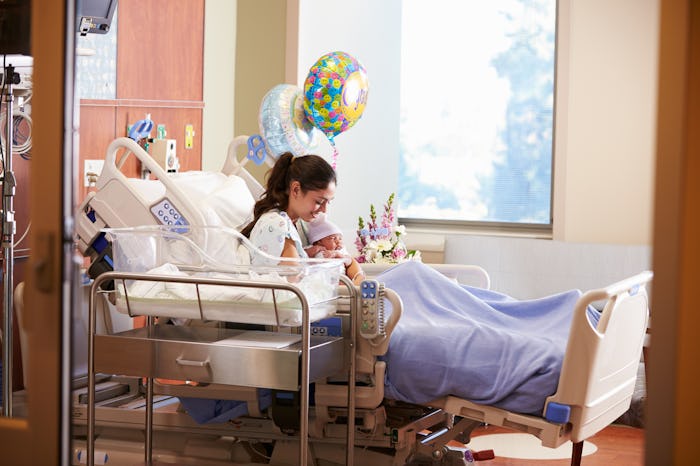Life

Here's What Your Hospital May Provide When It Comes To Sitz Baths
During my childbirth preparation class, in addition to the actual birth part, my instructor told the class about all the things we will be provided with on our “labor day.” She mentioned mesh panties, frozen pads, a squeeze bottle (for peeing), diapers for the baby, and a sitz bath kit, which apparently is a huge help postpartum. Sitz comes from the German word “sitzen,” which literally means to sit, according to WebMD — in case you were curious like me. Is this the norm for all hospitals? Does the hospital give you a sitz bath kit after you’ve given birth or do some women have to get their own kits to use at home?
Apparently I’m a pretty lucky gal, because according to Dr. Lisa Valle, an OB-GYN at Providence Saint John’s Health Center in Santa Monica, California, not all hospitals provide a sitz bath — whether in kit form or in general — after birth. “Each hospital is different and it depends on whether or not your physician or nurse midwife ordered one for you to use during your postpartum stay,” she says in an email interview with Romper.
And turns out, it’s not a super huge deal if your hospital or birthing center doesn’t offer one because thankfully, the sitz bath kits can be purchased at most drug stores. What are some advantages and needs for a sitz bath? According to Health Line, a sitz bath is used to help cleanse and heal your vaginal area and your perineum after childbirth. The kits usually come with a basin that fits into your toilet seat and it can be filled up with warm water. The way these kits work is the warm water increases blood flow to your genitals and in turn, speeds up the healing process, according to WebMD. You don’t even have to add stuff to the water — the warmth alone can sometimes work just fine. It’s supposed to “offer relief from soreness, burning, and inflammation, but you may need other treatments as well,” WebMD noted.
Parenting offered an herbal sitz bath recipe, which included a half of a cup of Epsom salt, two drops of witch hazel, one tablespoon of olive oil, two tablespoons of baking soda, and eight drops each of lavender essential oil and chamomile essential oil. Health Line mentioned that some doctors will even prescribe other additives like “povidone-iodine” for its antibacterial properties or “adding table salt, vinegar, or baking soda to the water.” However, just be 100 percent sure this is safe for your particular situation and clear it with your doctor first.
Otherwise, just fill either your freshly cleaned tub or sitz kit basin with 2 to 3 inches of warm water and settle in for 10 to 15 minutes. Pat the area dry after you’re finished, being careful not to rub too hard — you don’t want to undo all the good that you’ve just done for down there. WebMD says you can soak up to three times a day, but your doctor may suggest more depending on what’s going on down there.
As for any negatives to the sitz bath, they’re certainly minimal. Valle says it “would not be a good idea if a mom has difficulty ambulating or sitting up on her own.” She adds, “A sitz bath carries a small risk for infection if it has not been cleaned properly between uses.” Health Line also mentioned the risk of infection of the perineum, “but it rarely occurs.” An infection “may happen if you’re caring for a surgical wound and don’t clean the tub or plastic bath thoroughly,” the article noted.
While not all hospitals offer sitz baths or sitz bath kits postpartum, don’t worry too much. They’re easily obtainable from your local pharmacy or on Amazon. Otherwise, you can use a witch hazel pad — cooled or at room temperature — if that works better for you. Be sure to sit on something soft while you’re healing, like a pillow, as well.
Check out Romper's new video series, Bearing The Motherload, where disagreeing parents from different sides of an issue sit down with a mediator and talk about how to support (and not judge) each other’s parenting perspectives. New episodes air Mondays on Facebook.